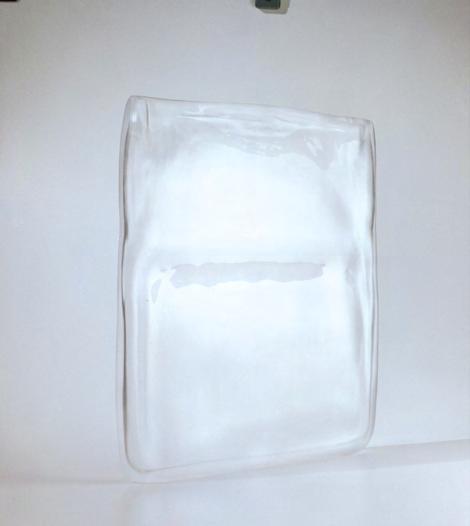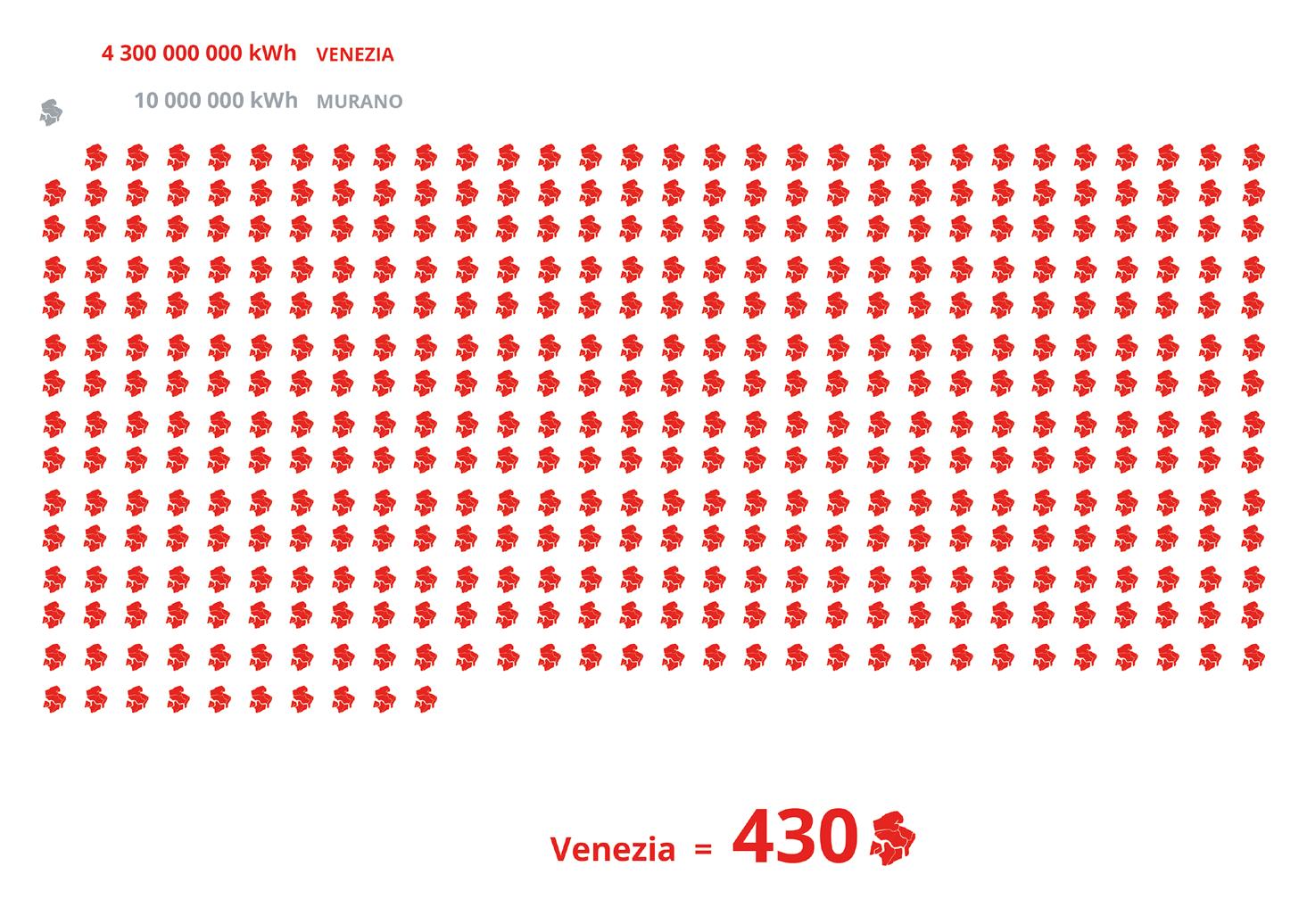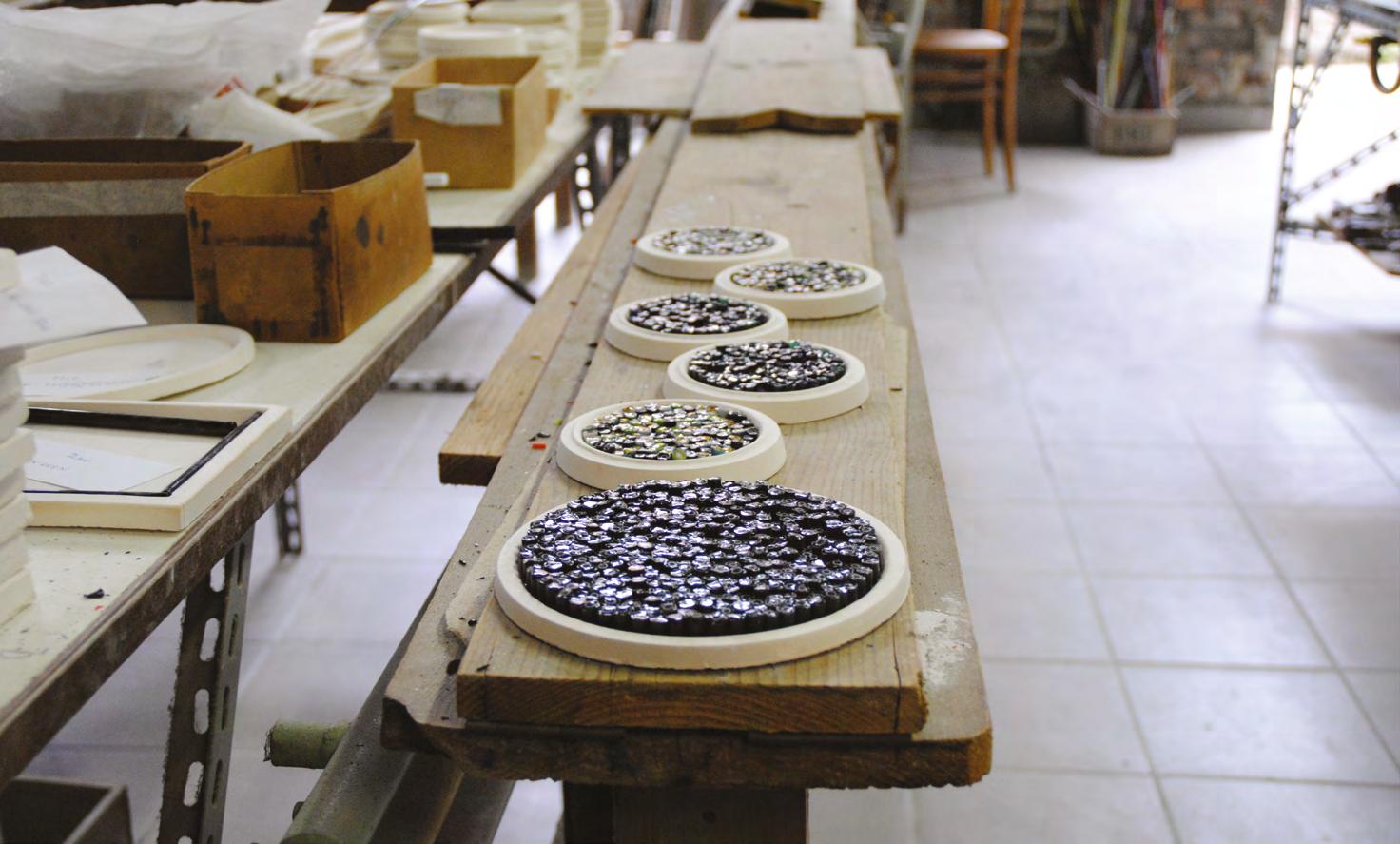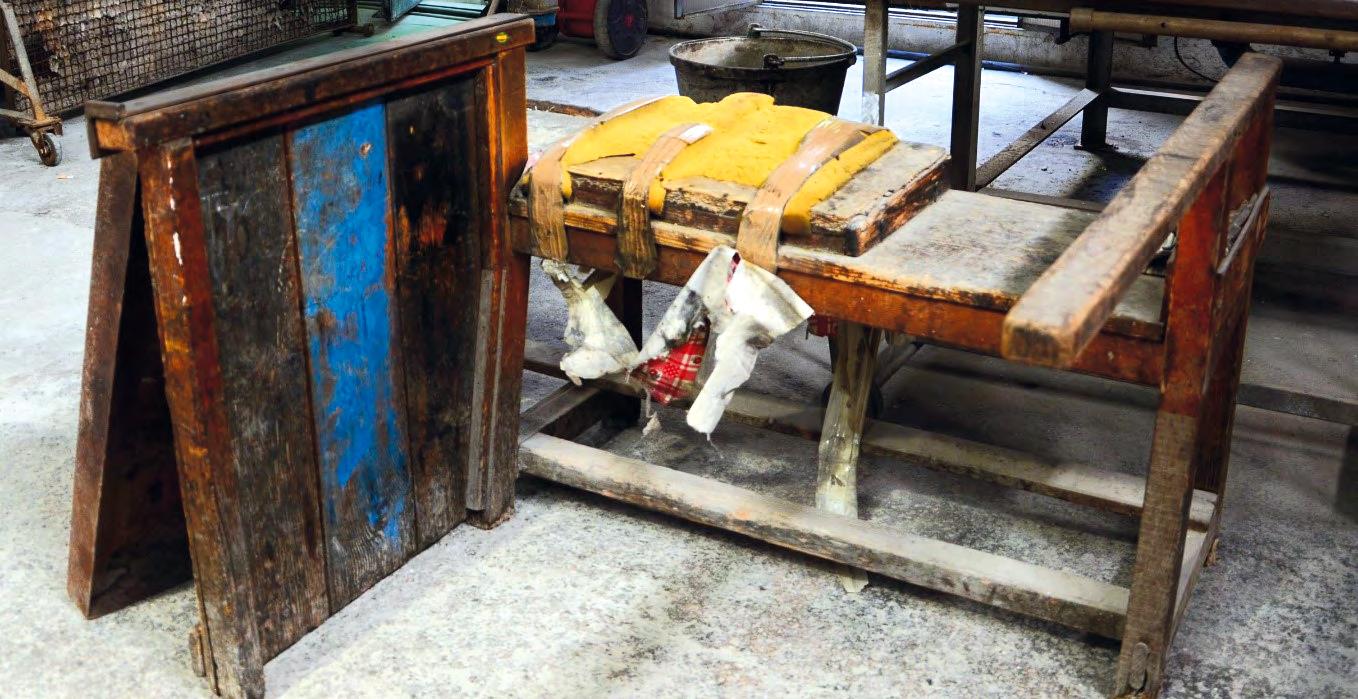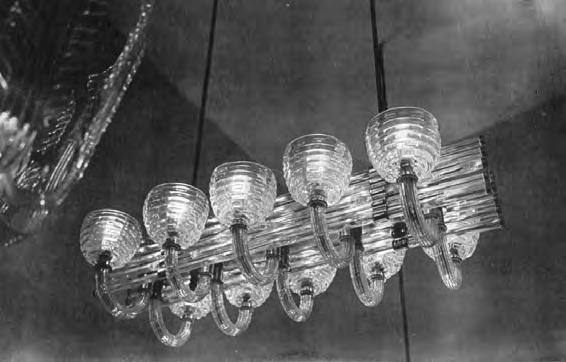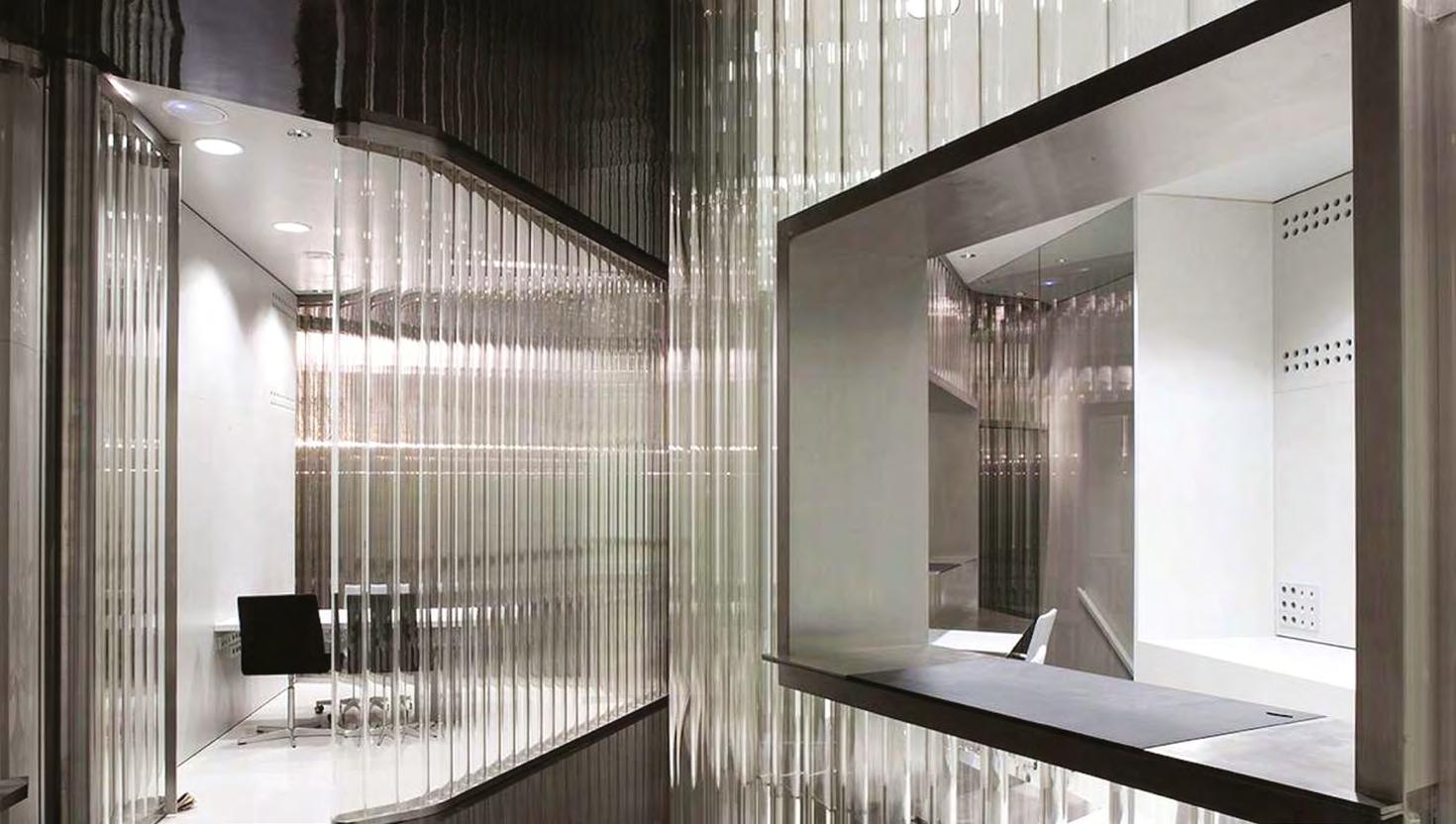
22 minute read
Insights into LCA and EPD environmental impacts data related to glass products for windows
ANNA DALLA VALLEA, MONICA LAVAGNAA, ANDREA CAMPIOLIA
KEYWORDS: GLASS PRODUCTS, ENVIRONMENTAL IMPACTS, LIFE CYCLE ASSESSMENT
In construction sector, glass products are widely used for the most varied purposes. Windows are however the main application field, crucial for guaranteeing the performance of building envelope as well as for ensuring the well-being of users, emphasizing the potential strategic role of glass in promoting sustainable development initiatives across multiple stakeholders. In this perspective, the paper focuses on the environmental impacts of the principal glass products for windows, providing an overview of the Life Cycle Assessment-based data retrieved from different sources, including EPD certifications and LCA database. The aim is to give insights into the environmental impacts of glass supply chain, to identify reference values (range minimum-maximum), to verify any differences between the internationally recognized datasets and the data of producers, to disclose the percentage increase that results from the various glass processing. The presented results are an integral part of Arcadia project, “Life cycle approach in public contracts and Italian LCA database for the efficient use of resources”, constituting in particular the preliminary analysis for the development of the representative datasets of the glass supply chain at national scale.
A Department of Architecture, Built environment and Construction engineering, Politecnico di Milano, Italy.
Introduction
From an environmental point of view, the glass industry has a twin distinction. On one hand, it constitutes a highly energy-intensive activity (Martini et al., 2021), requiring the use of high-temperature furnaces for the melting and forming processes, unlike other sectors in a constant and continuous way throughout the year (stops occur only for extraordinary maintenance or end-of-life). On the other hand, it has enormous potential for supporting the transition to the circular economy, as permanent material potentially fully recyclable, that can be melted, reproduced and used countless times without losing its properties and without needing additives or reagents (Scalet et al., 2013). This duality destines glass to play a role of particular interest, by identifying its possible energy efficiency interventions and specific technological solutions (Martini et al., 2021) and by defining its new frontiers to contribute to a zero-emission Europe (Glass for Europe, 2019).
The environmental impact of glass is especially critical in the construction sector, which represents its main field of application (80% of total production), followed by automotive and solar sectors (Glass for Europe, 2021). In particular, after the 2020 crisis, in Italy the provision of incentives and the revival of investments in the construction sector contributed to a swift recovery of glass market (Assovetro, 2021), giving it a strategic importance for promoting sustainable development initiatives across multiple stakeholders. The glass supply chain is in fact one of the 15 national supply chains represented in the near future within the Italian LCA (Life Cycle Assessment) database, currently ongoing as part of Arcadia project. Funded by Agenzia di Coesione Territoriale (PON-governance and institutional capacity 2014-2020), Arcadia project focuses on “Life cycle approach in public contracts and Italian LCA database for the efficient use of resources”. The definition of welldocumented LCA datasets as national reference values, in this instance for the glass supply chain, has multiple purposes. Firstly, to stimulate production companies to improve their products, limiting energy consumption and emissions through the application of eco-innovation tools (e.g. EPD – Environmental Product Declaration and product eco-design). Secondly, to support Public Administrations in promoting LCA-based policies and measures concerning land-use planning and management as well as green public contracts. Last but not least, to provide national datasets available to research bodies and universities for teaching and research activities.
In this context, the research group LifeCycleTEAM of the ABC Department of Politecnico di Milano is in charge of developing the datasets for the glass products for windows. The paper shows the results of the preliminary analysis conducted in the field of environmental sustainability for the development of the representative glass datasets to be included in the Italian LCA database proposed by Arcadia project. This is a detailed and systematic review of the LCA-based environmental profiles of glass products now available on the market, collected from different sources: both EPD certifications and datasets specifically from Ecoinvent, an internationally established database. Objective of the paper is therefore to offer an overview of the
environmental information of glass supply chain, to identify a range of reference values (between minimum and maximum), to verify if Ecoinvent database is still valid or if there is a significant deviation from data of producers, to disclose the percentage increase that currently derives from the various glass processing.
The construction sector is characterized by the use of a wide range of glass products that, although different in function, performance and final appearance, entirely derive from flat glass, commonly called “float glass”, recalling the production process (float bath). Starting from float glass, the most representative processes at national level concern the deposition of coatings, the tempering and stratification, from which various types of monolithic glass pane are obtained and then assembled together to create high performance windows and transparent envelope solutions. The object of study are therefore the following representative products: float glass (FG), coated float glass (CFG), toughened safety glass (TSG), laminated safety glass (LSG) and insulated glass units (IGU), both double glazing (IGUd) and triple glazing (IGUt).
For each product at issue, the today available EPDs have been collected from the main EPD platforms, including Environdec, EcoPlatform, INIES, IBU-epd, EPD Italy, as well as from the database embedded within the user-friendly LCA tools for designers, such as OneClick LCA. Note that in this way, the surveyed EPDs refer to different Program Operators, ranging from International EPD System, ift Rosenheim, FDES, ASTM International and IBU. Nevertheless, after a first sweeping investigation, the EPDs to be further explored have been selected, preferring those developed in European context and, only in case of lack of data, referred to foreign contexts (USA and Saudi Arabia). Furthermore, the EPDs of glass products subjected to specific surface treatments (e.g. acid etching) and the EPDs developed in compliance with the new LCA rules (EN 15804:2012+A2:2019) have been eliminated, opting for basic processes and the widely adopted EPD standard (EN 15804:2012+A1:2013). By now it is worth mentioning that most glass EPDs are related to average data based on different production plants, thus determining for a specific glass producer the average environmental profiles within a specific application context (e.g. EU average).
The environmental profiles of the selected EPDs have been thus systematized and analyzed, focusing in particular on A1-A3 phases, relative to the upstream processes (procurement of raw materials and transport to manufacturing plant) and core processes (glass production and subsequent processing, even when performed at different factories). The downstream phases have been currently omitted as subject to higher degree of uncertainty and strongly determined by the underlying assumptions. Where EPDs contain a range of reference products, the environmental information is set out for specific product considered representative of the current glass market offerings. In this way, the typical thickness for the different glass products
is: 4 mm for float glass (10 kg/m2), 3 mm for coated and toughened glass (7.5 kg/m2), 7.5 mm for laminated glass (17.1 kg/m2). On the other hand, the following standard glass-cavity measures have been considered for insulated glass units: 4-16-4 for double glazing (about 20 kg/m2) and 4-14-4-14-4 for triple glazing (about 30 kg/m2). Subsequently, in order to ensure comparability of results among the different glass products, the environmental impacts of float glass and processed glasses (CFG, TSG and LSG) have been converted to 1 mm thick of 1 m2 of glass, with the aim of verifying the percentage increase due to the different processes.
In parallel with the collection and analysis of the EPD-sourced data, the environmental profiles of glass have been explored into Ecoinvent, the LCI database established at international level and contained in the main LCA software for experts (SimaPro and GaBi). Specifically, it includes the environmental information (datasets) only for a limited range of glass products: uncoated flat glass (FG), coated flat glass (CFG), double glazing (IGUd) and triple glazing (IGUt). Therefore, the datasets of both toughened safety glass and laminated safety glass are not present in Ecoinvent (LSG is actually embodied as additional component of double glazing dataset). It should be noted that in Ecoinvent glass datasets are expressed in kg, requiring therefore their transformation according to the functional unit considered in the study, namely 1 m2 of glass pane, considering weights equal to the representative products derived from the EPD survey. As regards insulated glass unit datasets, Ecoinvent already defines them per 1 m2. also specifying the relative transmittance: U <1.1 W/m2K for double glazing and U <0.5 W/m2K for triple glazing.
Following the systematic analysis of glass environmental profiles, both from EPD and Ecoinvent, results are shown by means of bar charts, not intended for statistical purposes but only to describe the range of the reference sample, to identify for each glass product the average impacts from the selected EPDs and the relative deviation from Ecoinvent datasets, as well as the impact percentage of increase associated with the processes in question. To this end, the investigation has been confined to the most significant indicators, namely: Global Warming Potential (GWP); Acidification Potential (AP); Eutrophication Potential (EP); Total use of Primary Energy resources, as sum of Renewable (PERT) and Not Renewable (PENRT), described in detail in the following paragraphs.
Focus on Global Warming Potential (GWP) impacts
From the analysis of the main EPDs currently available on the market, it emerges how GWP impacts of float glass ranges from 2.20 kgCO2eq to 3.25 kgCO2eq, placing the average value (2.75 kgCO2eq) above that set by Ecoinvent dataset “uncoated flat glass” (2.43 kgCO2eq), which is lower than -12%. The offset between the average EPD value and Ecoinvent data becomes even more pronounced in the case of coated glass, in which the average GWP value at 3.93 kgCO2eq is 34% higher than Ecoinvent dataset “coated flat glass” (2.61 kgCO2eq). GWP impacts varies from 3.46 kgCO2eq to 5.70 kgCO2eq in the event of toughened glass and from 6.53 kgCO2eq to 7.93 kgCO2eq when laminated
safety glass are produced. It is important to underline that the comparison among the different glass products refers to different glass manufacturers, so single values cannot be directly compared (e.g. the minimum value of coated glass exactly correspond to the minimum of toughened glass, seeming to imply equal impacts in terms of GWP during the production phase, but this is because the different impact of glass production related to different manufacturing plant). Note that Ecoinvent database does not currently include datasets for TSG and LSG processing to be used for comparison.
By comparing each other the GWP impacts of the different processed glasses, it is possible to disclose the percentage increase associated with each processing, starting from the float glass that corresponds to the reference base product. Considering the average EPD value of float glass at 2.75 kgCO2eq, the production of coated glass (3.93 kgCO2eq) entails an increase in impacts of 43%, reaching 66% in the case of toughened glass (4.58 kgCO2eq) and up to 163% for laminated glass (7.23 kgCO2eq). Instead, regarding GWP impacts available in Ecoinvent, coated glass (2.61 kgCO2eq) results in an increase of only 7% compared to uncoated float glass (2.43 kgCO2eq), narrowing the gap detected by surveying EPDs.
Moving from processed glasses to their assembly, the average EPD-sourced values of insulated glass units are more aligned with those of Ecoinvent, the latter always slightly lower. In the case of double glazing, the GWP impacts declared by producers in the EPDs ranges from 31.1 kgCO2eq to 39.2 kgCO2eq, whose average (35.5 kgCO2eq) is higher than 7% of the impacts by Ecoinvent (32.9 kgCO2eq). On the other hand, in the case of triple glazing, the Ecoinventsourced GWP (53.5 kgCO2eq) is only 2% lower than the average of EPD impacts (54.7 kgCO2eq) which vary from 49.6 kgCO2eq to 59.7 kgCO2eq. Here, the existing GWP deviation between double and triple glazing is fairly uniform between EPD averages and Ecoinvent values. In particular, in compliance with the average EPD impacts, the creation of triple glazing implies an increase in GWP impacts equal to 54% compared to double glazing, while to 63% considering the Ecoinvent datasets.
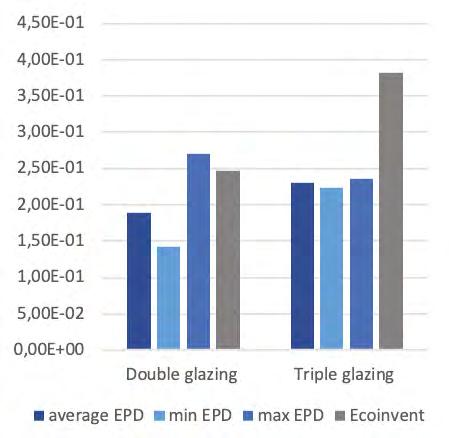
Fig. 01 GWP impacts [kgCO2eq/m2] of the different processed glass per 1 mm thick (sx) and of insulated glass units per 4-16-4 for double glazing and per 4-14-4-14-4 for triple glazing (dx).
Focus on Acidification Potential (AP) impacts
Concerning the impacts related to Acidification Potential of land and water, according to the analysis of existing EPDs, float glass is around 1.36E-02 kgSO2eq, now lower than that of Ecoinvent (2.15E-02 kgSO2eq) which appears to be +58%. The same variation in impacts, gradually rising (66%), is also found in the case of coated glass, in which the average EPD value (1.41E-02 kgSO2eq) is advantageous (lower) compared to the AP impacts of Ecoinvent dataset (2.33E-02 kgSO2eq). AP impacts show an average of about 2.42E-02 kgSO2eq for toughened glass and 3.32E-02 kgSO2eq for laminated glass, which however derive from a wide range of values, since the maximum more than double the minimum. Moreover, note that in both cases the minimum EPD value is approximately equally by toughened and laminated glass, referring however to different manufacturing plants.
From the calculation of the percentage variation between the different glass products, it points out that compared to average AP impacts of float glass (1.36E-02 kgSO2eq), there is an increase respectively of 3% for coated glass (1.41E-02 kgSO2eq), 78% for toughened glass (2.42E-02 kgSO2eq) and 143% for laminated glass (3.32E-02 kgSO2eq). This is accounting the impacts specified within the EPDs and mostly confirmed by the available Ecoinvent impacts, where coated flat glass (2.33E-02 kgSO2eq) increases by 9% the emissions of float glass (2.15E-02 kgSO2eq), resulting therefore very similar to each other.
AP impacts of insulated glass units widely oscillate in the case of double glazing EPDs, in which maximum is nearly twice the minimum value, by contrast they fluctuate in a relatively narrow range in the triple glazing EPDs, with a variation of only 5%. Considering all collected EPDs, the average value is 1.88E-01 kgSO2eq for double glazing and 2.30E-01 kgSO2eq for triple glazing. They are both lower than the impacts of Ecoinvent datasets, which result in an increase of 31% for IGUd (2.47E-01 kgSO2eq) and of 66% for IGUt (3.81E01 kgSO2eq). Here, the percentage increase of impacts between double and triple glazing is 22% considering the EPD averages, increased up to 54% when embracing Ecoinvent datasets.
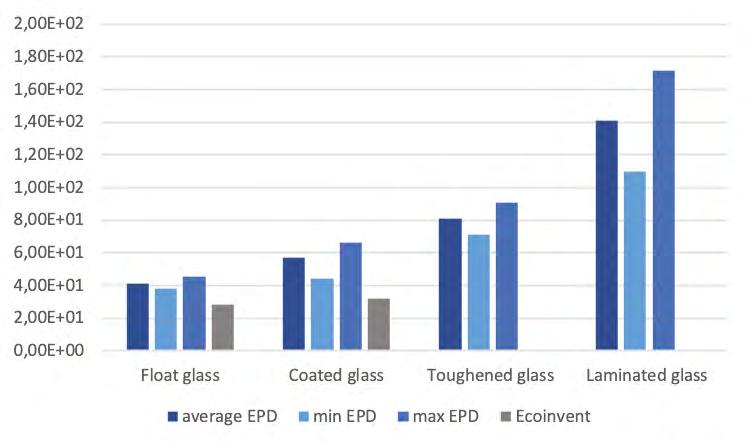
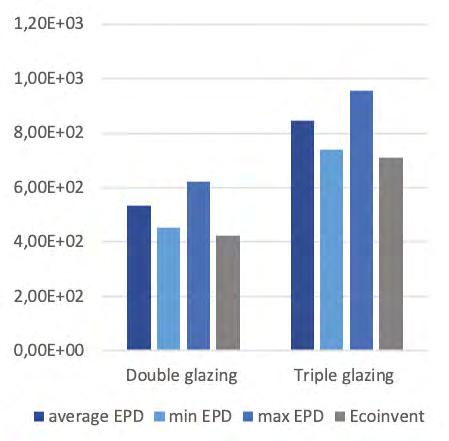
Fig. 02 AP impacts [kgSO2eq/m2] of the different processed glass per 1 mm thick (sx) and of insulated glass units per 4-16-4 for double glazing and per 4-14-4-14-4 for triple glazing (dx).
Focus on Eutrophication Potential (EP) impacts
From the analyzes conducted on Eutrophication potential of glass, there is a trend reversal in the sense that EP impacts appear higher for float glass compared to all those of coated, toughened and laminated glasses. It must be kept in mind that the impacts of processed glass (CFG, TSG, LSG) include both the impacts associated with the production of float glass and the ones relating to the subsequent processing. In this way, it seems that the treatment processes allow to reduce the EP impacts of glass production, but always taking into consideration that impacts refers to different manufacturing plants with distinguishing features of the production process. Anyhow, the EPD-sourced impact of float glass ranges from 1.49E-03 kgPO43-eq to 4.55E-03 kgPO43-eq, gaining an average of 3.01E-03 kgPO43-eq. This shows a significant variation in EP impacts of float glass (about 67%), which is also confirmed by the processed glass from EPDs, with range of 53% for coated glass, 63% for toughened glass and 70% for laminated glass. Compared to EPD average values, if the impacts of Ecoinvent datasets are advantageous (lower) by 9% for float glass (2.74E-03 kgPO43-eq), they turn out to be disadvantageous (higher) at 98% in the case of coated glass (3.31E-03 kgPO43eq). However, unlike EPD data, it is important to stress that in Ecoinvent the EP impacts of float glass are lower than those of coated glass.
In light of this, it is not possible to make comparison between float glass and processed glasses. Accordingly, taking as reference point the average EPD impacts of coated glass (1.67E-03 kgPO43-eq), a 16% increase in impacts is disclosed for toughened glass production (1.94E-03 kgPO43-eq) and up to 65% for laminated glass (2.67E-03 kgPO43-eq). Instead, by calculating the difference between float glass (2.74E-03 kgPO43-eq) and coated glass (3.31E-03 kgPO43-eq) set by Ecoinvent datasets, the EP percentage change amounts to about 21%.
As regards the double glazing, the variation between the minimum and maximum EP impacts retrieved from EPDs of both double and triple glazing is around 44%, obtaining as average value 2.88E-02 kgPO43-eq for IGUd and 4.57E02 kgPO43-eq for IGUt. Compared to these, the impacts from Ecoinvent are significantly higher in both cases, with a difference in EP impacts equal to 71% in
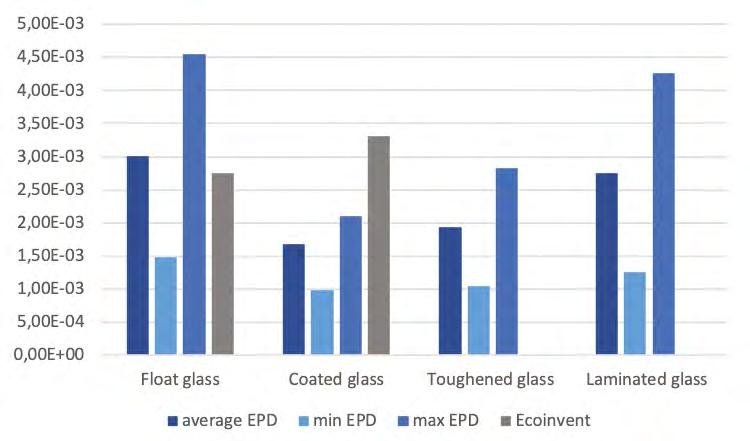
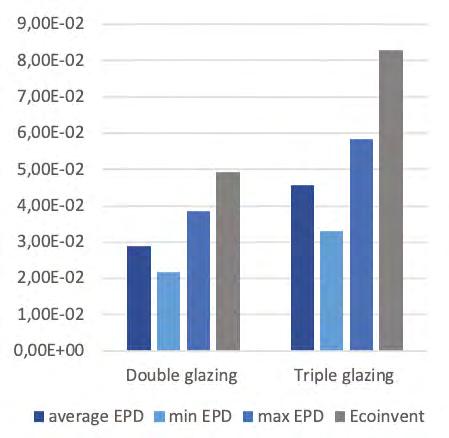
Fig. 03 EP impacts [kgPO43-eq/m2] of the different processed glass per 1 mm thick (sx) and of insulated glass units per 4-16-4 for double glazing and per 4-14-4-14-4 for triple glazing (dx).
double glazing (4.94E-02 kgPO43-eq) and 81% in triple glazing (8.28E-02 kgPO43eq). Although Ecoinvent data turns out to be more disadvantageous (higher) than those from EPD, the percentage increase in impacts is similar between the two. If considering the EPD averages, the production of insulated glass units with triple glazing involves a 58% increase in EP impacts compared to double glazing, this percentage reaches 68% when referred to Ecoinvent impacts.
Focus on Total use of Primary Energy Resources (PERT+PENRT) impacts
By deepening the total use of renewable and not renewable primary energy resources, the range between minimum and maximum values disclosed by EPDs appears more restrained, limited to 16% in float glass, raised to 34% in coated glass, to 22% in toughened glass and to 36% in laminated glass. However, the relative average impacts come in sequence, starting from 41 MJ for the production of float glass to about 57 MJ, 80 MJ and 141 MJ for the production of processed glass (CFG, TSG, LSG respectively). By comparing the different glass products embedded in Ecoinvent, it emerges that the datasets show more advantageous (lower) energy impacts both in the case of float glass, with total value at around 28 MJ (reduction of -30% compared to average EPD) and of coated glass equal to 32 MJ (-44% reduction).
In this context, it is possible to point out how the total use of primary energy resources with respect to the average EPD value of float glass (41 MJ) is increased up to 39% for the manufacturing of coated glass, 96% for toughened glass and 243% for laminated glass. This percentage variation is significantly reduced in the energy values available in Ecoinvent, where the production of coated glass (32 MJ) leads to an increase by only 11% from float glass (28 MJ).
Energy consumption from both renewable and non-renewable sources is greatly extended for the production of double glazing, reaching average EPD impacts of 489 MJ for double glazing and 848 MJ for triple glazing. In both, the variation between minimum and maximum values is around 25%. Furthermore, as happens for the different glass products, Ecoinvent impacts appear to be slightly lower than those of EPD, showing a reduction of -13% in double glazing (425 MJ) and -16% in triple glazing (711 MJ). It follows that the percentage increase in the impacts of triple
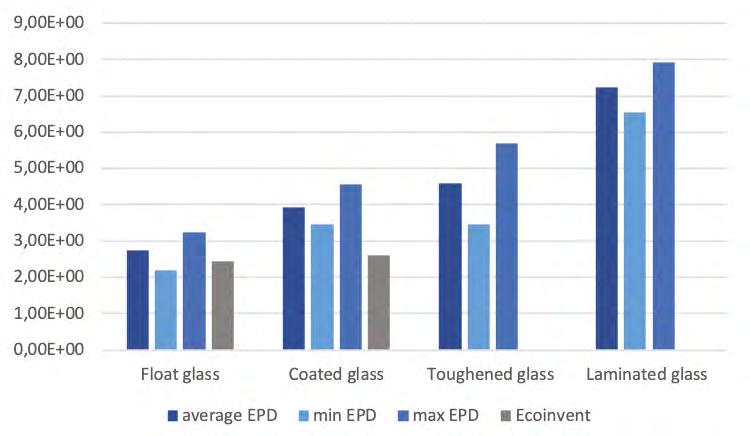
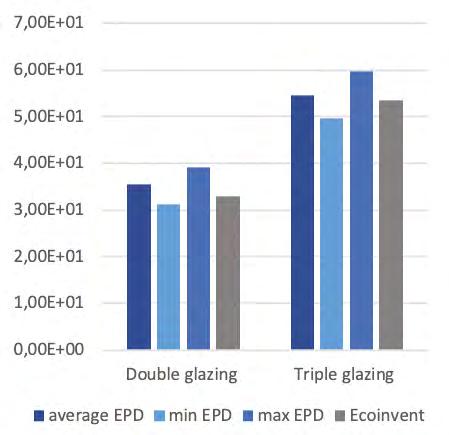
Fig. 04 PERT+PERNT impacts [MJ/m2] of the different processed glass per 1 mm thick (sx) and of insulated glass units per 4-16-4 for double glazing and per 4-14-4-14-4 for triple glazing (dx).
glazing from double glazing is almost aligned between average EPD values, in which it is at 73%, and between Ecoinvent impacts, where it is slightly reduced to 67%.
Conclusions
The in-depth review of the environmental data currently available for the glass industry emphasizes a significant variability of impacts depending on the source, including EPD certifications and Ecoinvent datasets. This places the attention on the importance of a continuous updating of environmental data, to not make them become obsolete but rather to grasp the technological evolution and progress over time. Moreover, only the provision of the metadata behind the LCA studies can evidence what causes the data deviations from different producers of each specific glass product, as well as the percentage increases that emerge for each processing. For this reason, the goal of Arcadia project, namely the definition of updated reference values for the Italian glass industry, turns out to be a challenging task.
To start solving the gap, the research team is currently looking into the inventory data, on one hand, underlying the LCA studies aimed at EPD certification and, on the other, at the development of LCI datasets. However, while Ecoinvent makes available the inventory in a transparent manner and therefore allows users to identify not only quantitative data (foreground system) but also environmental data (background system), EPDs generally omit this information, as they are not currently mandatory to declare. Despite this, some EPDs disclose a summary table of the input materials and the relative quantities in mass percentage on the final product. This enables a preliminary comparison between the quantitative inventory data considered in the EPDs versus Ecoinvent datasets, highlighting the main differences. In particular, concerning float glass, a different percentage is found for forming materials (silica sand and potentially external cullet) and intermediate materials (sodium carbonate, dolomite, limestone, feldspar, sodium sulphate). Based on 100% of float glass, in Ecoinvent silica sand is at 48%, whereas in EPD the average value of forming materials is around 60%. With regard to coated glass, it is important to define the metal oxides used for coating. Moreover, for insulated glass units, discrepancies emerge between double glazing and triple glazing. In Ecoinvent the double-glazing impacts are calculated considering a share of 90% of float glass, while in some EPDs the amount of glass reaches up to 97% of the total mass. In addition, the cavity of double glazing is accounted as argon filled in Ecoinvent, in line with most EPDs, except some that declare various gases, including dehydrated air, argon, krypton or xenon. Instead, in the case of triple glazing, the percentage of glass is aligned between EPDs and Ecoinvent inventories, resulting at 95% of the total mass. Here, a discrepancy is detected for the filling gas, since Ecoinvent dataset of triple glass includes krypton, unlike the majority of EPDs that consider insulated glass units as argon filled. Even here, however, there are EPDs that refer to the wide range of possible gasses.
The identification of the representative products – in terms of composition, process, technologies, techniques, thickness and, in the case of insulated glass
units, the arrangement between glass panes and filling gas – is closely linked to the inventory topic. However, this requires the support of glass trade associations and producers active in Italy and their willingness to collaborate, not only to identify the representative products, but also to solve the open issues in the field of environmental impacts, as outlined in previous paragraphs. They are surely sensitive data, but equally crucial for defining the environmental profile derived from the production and processing of glass in the national context. Given the need for clarity on the environmental sustainability of glass, the development of Arcadia project could also be for the principal stakeholders and in general for the glass industry an opportunity for discussion not to be missed but rather to be exploited to the maximum in order to define conscious and shared reference impacts at Italian level. In the near future, the solved issues could be then introduced at European scale to offer aware environmental data and orient glass industry with a view to sustainability.
References
AGC Glass Europe (2018). EPD PLANIBEL (Clear, Clearlite, Clearvision, Linea Azzurra, Coloured). FDES INIES. AGC Glass Europe (2019). EPD Low-e/solar control double glazing units. FDES INIES. AGC Glass Europe (2019). EPD Triple glazing units. FDES INIES. AGC Glass Europe (2020). EPD Solar control magnetron coated glass (ipasol, Stopray). FDES INIES. Arcadia Project (2019). Approccio ciclo di vita nei contratti pubblici e banca dati italiana LCA per l’uso efficiente delle risorse (online). In http://bancadatiitalianalca.enea.it (last accessed June 2022). Assovetro (2021). Quarta edizione dell’Osservatorio sulla trasformazione del vetro piano. Rassegna stampa (online). In www. assovetro.it/wp-content/uploads/2021/12/RASSEGNA-OSSERVATORIO-VETRO-PIANO-2021.pdf (last accessed June 2022). Astisglass SL (2020). EPD Insulating glass unit Guardian Sun. Kiwa BCS Öko-Garantie GmbH. Cardinal Glass Industries (2020). EPD Laminated glass products. ASTM International. Cardinal Glass Industries (2020). EPD Processed glass products. ASTM International. Ecoinvent (2019). Flat glass, coated {RER}| production | Cut-off, U. Dataset Ecoinvent v.3.6. Ecoinvent (2019). Flat glass, uncoated {RER}| production | Cut-off, U. Dataset Ecoinvent v.3.6. Ecoinvent (2019). Glazing, double, U<1.1 W/m2K {RER}| production | Cut-off, U. Dataset Ecoinvent v.3.6. Ecoinvent (2019). Glazing, double, U<1.1 W/m2K, laminated safety glass {RER}| production | Cut-off, U. Dataset Ecoinvent v.3.6. Ecoinvent (2019). Glazing, triple, U<0.5 W/m2K {RER}| production | Cut-off, U. Dataset Ecoinvent v.3.6. EN 15804:2012+A1:2013 (2014). Sustainability of construction works — Environmental product declarations — Core rules for the product category of construction products. EN 15804:2012+A2:2019 (2020). Sustainability of construction works – Environmental product declarations – Core rules for the product category of construction products. Euroglas SA (2020). EPD Clear float glass. FDES INIES. Glass for Europe (2019). 2050: il vetro piano nell’Europa a emissioni zero. Innescare un ciclo virtuoso di decarbonizzazione (online). In www.glassforeurope.com/wp-content/uploads/2020/10/Decarb_broch_ITALIAN_for_WEB.pdf (last accessed June 2022). Glass for Europe (2021). Key data of Europe’s flat glass sector (online). In www.glassforeurope.com/the-sector/key-data/ (last accessed June 2022). Martini, C., Martini, F., Salvio, M., Toro, C. (2021). Quaderni dell’efficienza energetica: vetro. Enea (online). In www.pubblicazioni. enea.it/component/jdownloads/?task=download.send&id=451&catid=3&m=0&Itemid=101 (last accessed June 2022). Pilkington IGP (2017). EPD Flat glass, toughened safety glass and laminated safety glass. ift Rosenheim GmbH. Saint-Gobain Glass Industry (2016). EPD SGG DIAMANT Extra clear low-iron glass. International EPD System. Saint-Gobain Glass Industry (2016). EPD SGG PLANICLEAR Clear float glass. International EPD System. Saint-Gobain Glass Solutions (2016). EPD CLIMAPLUS/CLIMALIT PLUS High performance double glazing. International EPD System. Saint-Gobain Glass Solutions (2016). EPD CLIMATOP High performance triple glazing. International EPD System. Scalet, B.M., Garcia Muñoz, M., Sissa, A.Q., Roudier, S., Delgado Sancho, L. (2013). Best Available Techniques (BAT) Reference Document for the Manufacture of Glass. European Commission, Joint Research Centre (online). In op.europa.eu/it/publication-detail/-/publication/ff8a3955-d0d0-46f5-8a15-4b638896cb56 (last accessed June 2022). Trakya Cam Sanayii A.Ş. (2017). EPD Clear Laminated Glass. Institut Bauen und Umwelt e.V.

